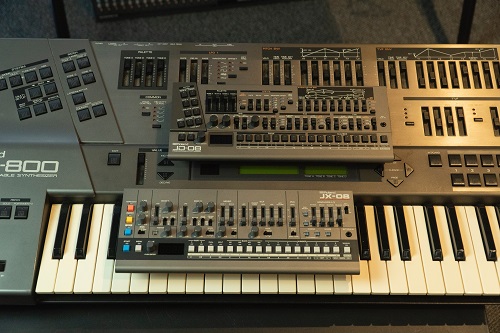They Promised Guitar Sounds on Your Piano Keyboard - Why do they suck?
If you've ever played an electric guitar through a keyboard amplifier, then you know that they never sound exactly the same. The keyboard amplifies the sound of the guitar in a different way than a regular amplifier, resulting in a slightly different tone. It's hard to create the same seamless chord sound as you would on a real guitar, even while playing chords. Why is that electric guitars in keyboards don't always sound right? In this blog post, we'll take a look at some of the reasons why.
We need to figure out what's going on in order to improve the sound of your piano performances. Take note!
The pickups in electric guitars create a signal that is sent to an amplifier which makes the sound louder and more distorted.
Both single-coil and humbucker pickups are common options for electric guitars. The vast majority of pickups on the market now are single-coil models. Single-coil pickups are the most common type of pickup found in electric guitars and are made up of a single piece of wire wrapped around a magnet. The coil produces a magnetic field, which interacts with the strings to create an electrical signal that is amplified and sent to an output device, such as an amplifier or speaker. These pickups are known for their bright, clear sound. However, because they are more susceptible to interference from outside sources such as power lines and computers, you might have to take some extra steps to reduce the amount of interference in your recordings.
On the other hand, humbucker pickups are made up of two coils of wire wound around a magnet. These pickups are designed to cancel out any outside interference, giving them a thicker, warmer sound. This makes them ideal for players who want to achieve a dense, rich tone without having to worry about outside noise bleed. This makes them ideal for rock and metal styles of music where you need to cut through the mix.
Keyboard pickups don't have the same effect because they are designed to create a clean sound without distortion.
The pickups on a keyboard are electromagnetic in nature and work by converting the vibrations of the strings into an electrical signal. This signal is then processed by an amplifier where it is turned into sound. The electromagnetic pickups are typically located underneath the keyboard's strings near the bridge. When a key is pressed, the corresponding string vibrates and causes a magnetic field. This field is then converted into an electrical signal that can be amplified to create sound.
Also, keyboard pickups are designed to produce a clean tone without any distortion. Distortion is created when the waveform of the signal being amplified is "clipped" or distorted. This happens when the signal exceeds the maximum amplitude that the amplifier can produce, and it results in a waveform that is squashed or flattened at the peaks. Keyboard pickups are particularly susceptible to this type of distortion because they have such a wide range of frequencies that they can pick up.
Some keyboard players use pedals to create distortion, but this can be difficult to control and can make the keyboard sound messy.
The sustain pedal can be used to create a more consistent distortion sound. To do this, hold down the sustain pedal and play a note or two on the keyboard. Then, release the pedal and let the notes decay naturally. You can also use a hold button on your keyboard to create a similar effect. This will cause the notes to continue sounding until the button is released, even if you take your hands off the keyboard.
If you're looking to add a bit of character to your keyboard sound, you might want to try using a distortion pedal. These pedals can be quite finicky to control, so it's often best to start with a clean sound and then slowly add in the distortion. That way, you can get a feel for how the pedal interacts with your playing style and make any necessary adjustments.
Some keyboard players use software plugins to create distortion, but these can also be difficult to use and can affect the quality of the sound.
If you want to create a more powerful sound, you can try using a guitar pedal. pedals can help your guitar sound fuller and louder. they can also give your sound more depth and texture. Some of the most popular distortion pedals include the Boss DS-1 Distortion, the Ibanez Tube Screamer, and the Digitech Metal Master. Each pedal has its own distinct sound, so it's important to experiment with different pedals to find the one that best suits your style. These pedals are all great for adding a bit of grit and attitude to your tone, and can help you create some truly unique sounds.
Once you've found the perfect distortion pedal for your needs, there are a few things you can do to get the most out of it. First, make sure that your amplifier is set to the correct input level. This will ensure that your pedal is getting the right amount of power and won't be overdriven.
Next, experiment with the placement of the pedal in your signal chain. For example, if you're using a distortion pedal with a clean amplifier, try placing the pedal before the amp's distortion stage. This will give you a rougher, more aggressive sound. On the other hand, if you're using the pedal with an already-distorted amp, try placing it after the amp's distortion stage. This will give you a cleaner, more controlled sound.
Finally, play around with the EQ controls on your distortion pedal to shape the sound to your liking. Most pedals will have controls for bass, mids, and treble. You can use the EQ controls to make the sound more muddy or clean. If you want to make the sound have more sustain, try playing with the mids control.
Conclusion
It can be challenging to get a good sound out of an electric guitar played through a piano or digital electric keyboard, but it can be done with the right type of amplifier and by using the correct pedals or plugins. If you're not willing to put in the time to learn how to play the electric guitar, it's probably best to just stick with a piano keyboard. However, if you're willing to experiment, you can get some great sounds out of an electric guitar by plugging it into a electric keyboard.
Harlan Kilstein began playing piano during covid with no piano background at all. He taught himself how to play learning what to do and what not to do.
Today he's an advanced intermediate player and can help you grow in your skills because he learned all this on his own.








